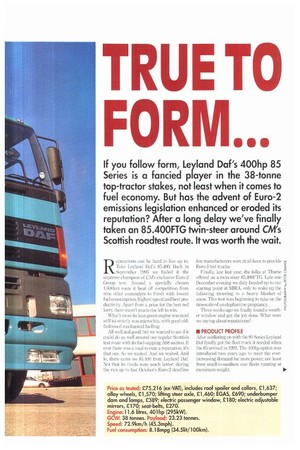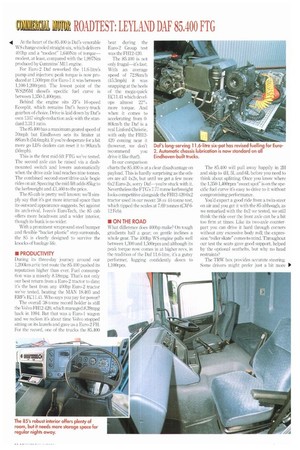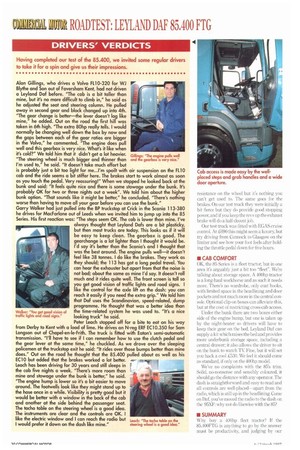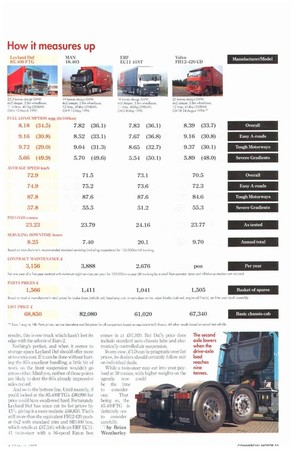TRUE TO
Page 29

Page 30

Page 32

Page 33

If you've noticed an error in this article please click here to report it so we can fix it.
If you follow form, Leyland Daf's 400hp 85 Series is a fancied player in the 38-tonne top-tractor stakes, not least when it comes to fuel economy. But has the advent of Euro-2 emissions legislation enhanced or eroded its reputation? After a long delay we've finally taken an 85.400FTG twin-steer around CM's Scottish roadtest route. It was worth the wait.
Reputations can be hard to live up to. Take Le.yland Daf's 85.400. Back in September 1995 we hailed it the supreme champion of CM's exclusive Euro-2 Group test. Around a specially chosen 1,600km route it beat off competition from nine other contenders to finish with lowest fuel consumption, highest speed and best productivity Apart from a prize for the best red lorry, there wasn't much else left to win.
What's more its lean green engine was (and still is) strictly non-microchip, with good oldfashioned mechanical fuelling.
All well and good, but we wanted to see if it could do as well around our regular Scottish test route with its fuel-sapping A68 section. If ever there was a road to ruin a reputation, it's that one. So we waited. And we waited. And le, there came no 85,400 from Leyland Daf. Not that its rivals were much better: during the run up To last October's Plro-2 deadline few manufacturers were at all keen to provide Euro-2 test trucks.
Finally, late last year, the folks at Thame offered us a twin-steer 85.400FTG. Late one December evening we duly headed up to our starting point at MIRA, only to wake up the following morning to a heavy blanket of snow. This test was beginning to take on the timescale of an elephantine pregnancy.
Three weeks ago we finally found a weather window and got the job done. What were we saying about reputations?
• PRODUCT PROFILE
After soldiering on with the 95 Series Leyland lid finally got the fleet truck it needed when the 85 arrived in 1992. The 400hp option was introduced two years ago to meet the everincreasing demand for more power, not least from small-to-medium size fleets running at maximum weight. 110.
At the heart of the 85.100 is L)af's venerable WS charge-cooled straight-six, which delivers 401hp and a "modest" 1,640Nm of torque— modest, at least, compared with the 1.997Nm produced by Cummins' MI1 engine.
For Euro-2 Daf reworked the 11.6-litre's pump and injectors: peak torque is now produced at 1,500rpm (for Euro-1 it was between 1,100-1.200rpm). The lowest point of the WS295M diesel's specific fuel curve is between 1,350-1,400rpm.
Behind the engine sits ZF's 16-speed Ecosplit, which remains Dais heavy-truck gearbox of choice. Drive is laid down by Dais own 1347 single-reduction axle with the standard 3.31:1 ratio.
The 85.400 has a maximum geared speed of 70mph but Eindhoven sets its limiter at 88km/h (54.6mph). If you're desperate for a bit more go LD's dealers can reset it to 90km/h (56mph).
This is the first mid-lift FTG we've tested. The second axle can be raised via a dashmounted switch and lowers automatically when the drive axle load reaches nine tonnes. The combined second-steer/drive-axle bogie rides on air. Speccing the mid-lift adds 85kg to the kerbweight and £.1,460 to the price.
The 85 cab is pretty well known: we'll simply say that it's got more internal space than its outward appearance suggests. Set against its arch-rival, lveco's EuroTech. the 85 cab offers more headroom and a wider interior, though its bunk is no wider.
With a prominent wrapround steel bumper and flexible "bucket plastic" step surrounds, the 85 is clearly designed to survive the knocks of haulage life.
• PRODUCTIVITY During its three-day journey around our 1,200km artic test route the 85.400 pushed its reputation higher than ever. Fuel consumption was a miserly 8.18mpg. That's not only our best return from a Euro-2 tractor to date; it's the best from any 4(X)hp Euro-2 tractor we've tested, beating the MAN 18.403 and ER F's EC11.41. Who says you pay for power?
The overall 38-tonne record holder is still the Volvo FH12-420, which managed 8.39mpg back in 1994. But that was a Euro-1 wagon and we reckon it's about time Volvo stopped sitting on its laurels and gave us a Euro-2 Fl-I. For the record, one of the trucks the 85.400 beat during the Euro-2 Group test was the F1412-420.
The 85.400 is not only frugal—it's fast. With an average speed of 72.9km/h (45.3mph) it was snapping at the heels of the mega-quick EC11.41 which develops almost 22°0 more torque. And when it conies to accelerating from 080km/11 the Daf is a real Linford Christie, with only the F1112420 coming near it (however, we don't recommend you drive it like that!).
In our comparison charts the 85.400 is at a clear disadvantage on payload. This is hardly surprising as the others are all 4x2s, but until we get a few more 6x2 Euro-2s. sorry Daf—you're stuck with it. Nevertheless the FTG's 7.77-tonne kerbweight kxiks competitive alongside the H-I12-420 6x2 tractor used in our recent 38 vs 44-tonne test, which tipped the scales at 7.69 tonnes (CM 612 Feb).
• ON THE ROAD What difference does 40011p make? On tough gradients half a gear; on gentle inclines a whole gear. The 4(X)hp WS engine pulls well between 1,300 and 1,500rpm and although its peak torque now comes in at higher revs, in the tradition of the Daf 11.6-litre, it's a gutsy performer, lugging confidently clown to 1,10Orpm. The 85.400 will pull away happily in 211 and skip to 411, 5L and 6L before you need to think about splitting. Once you know where the 1,350-1,400rpm "sweet spot" is on the specific fuel curve it's easy to drive to it without compromising performance.
You'd expect a good ride from a twin-steer on air and you get it with the 85 although, as we remarked with the 4x2 we tested, we still think the ride over the front axle can be a bit too firm at times. Like its two-axle counterpart you can drive it hard through corners without any excessive body roll; the expression "roller skate" conies to mind. Throughout our test the scats gave good support, helped by the optional seatbelts, but why no head restraints?
The TRW box provides accurate steering. Some drivers might prefer just a bit more 1 resistance on the wheel but it's nothing you can't get used to. The same goes for the brakes, On our test truck they were initially a bit fierce but they do provide good stopping power, and if you keep the revs up the exhaust brake will do a half-decent job.
Our test truck was fitted with EG AS cruise control. At £690 this might seem a luxury, hut try driving from Cannock to Glasgow on the limiter and see how your foot feels after holding the throttle pedal down for five hours.
MI CAB COMFORT OK, the 85 Series is a fleet tractor, but in one area it's arguably just a hit too "fleet". Were talking about storage space. A 400hp tractor is a long-haul workhorse and as such it needs more. There's no wardrobe, only coat hooks, with limited space in the headlining and door pockets and not much more in the central console, Optional clip-on boxes can alleviate this, but at the cost of restricting cross-cab access.
Under the bunk there are two boxes either side of the engine hump, but one is taken up by the night-heater so drivers will have to keep their gear on the bed. Leyland Daf can supply a kit which raises the bed and provides more underbunk storage space, including a central drawer; it also allows the driver to sit on the bunk to watch TV Fine, but it will set you back a cool .030. We feel it should come as standard, if only on the 400hp model.
We've no complaints with the 85's trim, Solid, no-nonsense and sensibly coloured, it should go the distance with any operator. The dash is straightforward and easy to read and all controls are well-placed—apart from the radio, which is still up in the headlining. Come on Daf, you've moved the radio to the dash on the 95XF: why not do likewise with the 85?
• SUMMARY Why buy a 400hp fleet tractor? If the 85.40017G is anything to go by the answer must he productivity, and judging by our results, this is one truck which hasn't lost its edge with the advent of Euro-2.
Nothing's perfect, and when it comes to storage space Leyland Daf should offer more at no extra cost. If it can be done without hurting the 85's excellent handling, a little bit of work on the front suspension wouldn't go amiss either. Mind you, neither of those points are likely to dent the 85's already impressive sales record.
And so to the bottom line. Until recently, if you'd looked at the 85.400FTG's L'80,990 list price you'd have swallowed hard. Fortunately Leyland Daf has since cut its list prices by 15' giving it a more realistic .,C68,850. That's still more than the equivalent FH12-420 pusher 6x2 with standard trim and SR1400 box, which retails at C67,340, while an ERF EC11
tviii-seer with a 16-speed Eaton box comes in at 1:61,020. But Dais price does include standard auto chassis lube and electronically controlled air suspension.
In any case, if LD can be pragmatic over list prices, its dealers should certainly follow suit on individual deals.
While a twin-steer may ear into your payload at 38 tonnes, with higher weights on the agenda now could be the time to consider one. That being so, the 85.400F1'G is definitely one to consider carefully.
l7 by Brian Weatherley
































































































